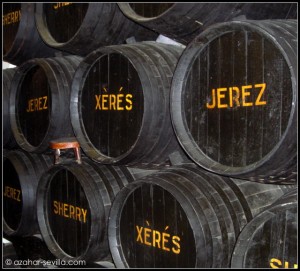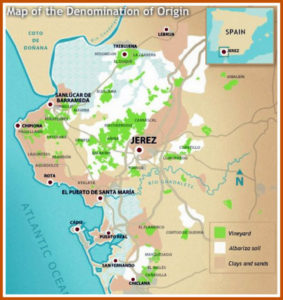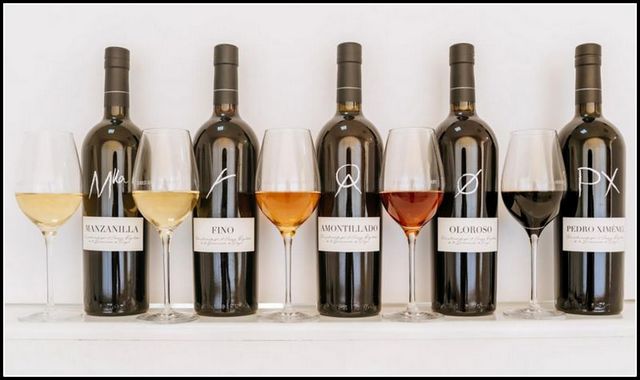 I think that sherry must be the most misunderstood wine in the world. For many the name usually conjures up images of grannies and Christmases when a rather musty bottle of something sweet would be produced from the back of a cupboard. But nothing could be further from the truth, and although I had long known, having lived in Spain for many years, that a majority of sherries are dry, and that a nice fino or manzanilla are just the thing to drink with your jamón, cheese and olives, I have to admit that it was only recently, about six years ago, that I started to get an understanding for the deeper qualities of these versatile wines. I have since successfully completed the Sherry Educator course (held annually by the Sherry Council in Jerez) and am happy to now be a certified sherry ambassador.
I think that sherry must be the most misunderstood wine in the world. For many the name usually conjures up images of grannies and Christmases when a rather musty bottle of something sweet would be produced from the back of a cupboard. But nothing could be further from the truth, and although I had long known, having lived in Spain for many years, that a majority of sherries are dry, and that a nice fino or manzanilla are just the thing to drink with your jamón, cheese and olives, I have to admit that it was only recently, about six years ago, that I started to get an understanding for the deeper qualities of these versatile wines. I have since successfully completed the Sherry Educator course (held annually by the Sherry Council in Jerez) and am happy to now be a certified sherry ambassador.
 The first thing to know about sherry is that it is a fortified wine which is produced in a small region in the province of Cádiz, known as the Sherry Triangle, that is roughly bordered by the towns of Jerez de la Frontera, Sanlúcar de Barrameda and El Puerto de Santa María. This Denomination of Origin was founded 80 years ago by the Consejo Regulador (Sherry Council), which has worked tirelessly to maintain this special recognition of these very exceptional wines. The soil and climate in this region play an important part in the distinct characteristics of sherry wines.
The first thing to know about sherry is that it is a fortified wine which is produced in a small region in the province of Cádiz, known as the Sherry Triangle, that is roughly bordered by the towns of Jerez de la Frontera, Sanlúcar de Barrameda and El Puerto de Santa María. This Denomination of Origin was founded 80 years ago by the Consejo Regulador (Sherry Council), which has worked tirelessly to maintain this special recognition of these very exceptional wines. The soil and climate in this region play an important part in the distinct characteristics of sherry wines.
 The other distinguishing factor about sherry comes from its unique ageing and blending process, known as the Solera System. With rare exception there are no vintage sherry wines. Sherry is always aged in American oak barrels, usually with a capacity of 600 litres, but they are only filled to 500 litres, and bottling only takes place from the solera casks, the ones closest to the floor (suelo). But these casks are never emptied. Depending on the bodega 200-300 litres will be removed for bottling, which is then replaced from the 1st Criadera (nursery), and in turn this is replaced by the next Criadera (there can be up to 5 or more Criaderas) until finally the new wines from the last harvest (sobretablas) are introduced into the system. This is known as fractional blending, and it helps guarantee a consistent quality which is not dependent on any particular harvest and, in the case of biological ageing, it replenishes the nutrients required to maintain the all important velo de flor. But I am getting ahead of myself.
The other distinguishing factor about sherry comes from its unique ageing and blending process, known as the Solera System. With rare exception there are no vintage sherry wines. Sherry is always aged in American oak barrels, usually with a capacity of 600 litres, but they are only filled to 500 litres, and bottling only takes place from the solera casks, the ones closest to the floor (suelo). But these casks are never emptied. Depending on the bodega 200-300 litres will be removed for bottling, which is then replaced from the 1st Criadera (nursery), and in turn this is replaced by the next Criadera (there can be up to 5 or more Criaderas) until finally the new wines from the last harvest (sobretablas) are introduced into the system. This is known as fractional blending, and it helps guarantee a consistent quality which is not dependent on any particular harvest and, in the case of biological ageing, it replenishes the nutrients required to maintain the all important velo de flor. But I am getting ahead of myself.
There are three types of grapes used to make sherry: palomino fino for the dry sherries, and moscatel and pedro ximenez for the naturally sweet wines. Within the Solera System you will find two distinct ageing processes: biological and oxidative. Beginning with the dry wines, the palomino fino grapes are harvested, usually late summer, and they are then fermented in stainless steel vats. The juice obtained from the first pressing is usually set aside for finos (and manzanillas), and second pressing tends to be used to make oloroso. So you have these two main categories – Fino (biological ageing) and Oloroso (oxidative ageing). After fermentation the must (approximately 11% alcohol) is reevaluated before being sent to the sobretabla for its first stint in barrels, usually about a year, before it is incorporated into the Solera System.
Biological Ageing
Wine destined to become finos are fortified to 15% before they are put in the sobretabla barrels. After this a natural yeast that lives in this region (in fact there are four different kinds) begins to form on the surface of the wine, eventually covering it completely. This is known as the velo de flor and it does two main things. It protects the wine from the oxygen at the top of the barrel and, because it’s alive and hungry, it eats pretty much all of the residual sugars and glycerine in the wine, as well as imparting its own special yeasty flavours. This makes fino/manzanilla the driest wine in the world.
Oxidative Ageing
Oloroso wines are fortified to 17-18% and at this level of alcohol the yeast can’t grow. So these wines have no protection from the oxygen and begins to interact differently with the wood, air, etc inside the barrel. As a result the colour becomes deeper (think of leaving an apple out) and, although still a dry wine, the flavours are much fuller and rounder than with finos.

Tasting notes courtesy of the Sherry Council.
Dry Sherries
Fino – Ranging from bright straw yellow to pale gold in colour. A sharp delicate bouquet with hits of almonds, fresh bread dough and wild herbs. Light, dry and delicate on the palate with a fresh aftertaste of almonds.
Manzanilla – A bright, pale straw coloured wine. Its distinctive bouquet with predominant floral aromas is reminiscent of camomile, almonds and freshly baked bread. Dry, fresh and delicate on the palate, with a light smooth taste and saline nuances. Light acidity produces a pleasant sensatino and freshness and a persistent dry finish.
Amontillado – an elegant wine that ranges from pale topaz to amber in colour. Its subtle delicate bouquet has hints of hazelnut, aromatic herbs and fine woods. Gentle on the palate with well-balanced acidity. A complex wine with a lingering aftertaste of dried fruit and wine-soaked wood.
Palo Cortado – A wine of great complexity which combines the delicate bouquet of an amontillado with the body and palate of an oloroso. Chestut to mahogany in colour with a comples bouquet and a deep, rounded and ample palate.
Oloroso – Ranging from rich amber to deep mahogany in colour. Warm, rounded, complex and powerful aromas, a toasted quality and hints of dried fruits and hazelnuts, fine wood, tobacco and dried leaves. Spicy notes and leathery aromas. Full flavoured and structured in the mouth. Very persistent aftertaste of fine wood which offers a highly elegant finish.
Blended Sweet Sherries
Pale Cream – Ranging from yellow straw to pale gold in colour. In the nose it shares the sharp bouquet of biologically aged wine, with hints of hazelnut and dough received from the flor. Light and fresh in the mouth but with a delicate sweetness which is pleasant on the palate and reduces the bitter aftertaste of biologically aged wines, which are naturally very dry.
Medium – Ranging from amber to dark chestnut in colour, medium sherry has a liquorous amontillado-like bouquet with the smoothly sweet notes of pastries, quince jelly or baked apple. It starts slightly dry in the mouth, gradually becoming sweeter to finish with a smooth vaporous aftertaste.
Cream – Ranging from chestnut brown to dark mahogany in colour this wine has a dense, syrupy appearance. A strong oloroso bouquet in the nose combines with a hint of sweetness reminiscent of roasted nuts, such as in nougat or caramel. Full bodied and velvety in the mouth with a well-balanced sweetness.
Naturally Sweet
Moscatel – Ranging from chestnut to an intense mahogany in colour, with a pronounced density and tearing. The characteristic varietal notes of muscatel grapes stand out in the nose with the presence of the floral aromas of jasmine, orange blossom and honey suckle in addition to citric notes of lime and grapefruit and other hints of sweetness. It has a restrainedly sweet palate with predominant varietal and floral notes leading to a slightly dry, bitter finish.
Pedro Ximenez – A dark, ebony coloured wine with pronounced tearing and a thickness to the eye. In the nose its bouquet is extremely rich with predominantly sweet notes of dried fruits such as raisins, figs and dates, accompanied by the aromas of honey, grape syrup, jam and candied fruit, at the same time reminiscent of toasted coffee, dark chocolate, cocoa and liquorice. Velvety and syrupy in the mouth and yet with enough acidity to mitigate the extreme sweetness and warmth of the alcohol leading to a lingering, tasty finish.
See all the sherry bodegas I have visited here…
For more information about my Sherry & Tapas Tour get in touch at…